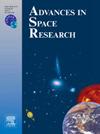实时 GNSS PPP 和 INS 的紧密集成:无电离层组合模型与非组合模型的对比
IF 2.8
3区 地球科学
Q2 ASTRONOMY & ASTROPHYSICS
引用次数: 0
摘要
全球导航卫星系统精确点定位(PPP)模型通常以无电离层(IF)组合形式或非组合(UC)形式建立。这两种形式在理论上是等效的,但在实际应用中与外部传感器集成后,其性能仍会有所不同。在本研究中,我们使用高级惯性测量单元(IMU)在实际车辆导航测试中比较了与惯性导航系统(INS)紧密结合的两种 PPP 模型的定位性能。在对 GNSS 原始代码和相位测量应用可观测特定偏差(OSB)后,两个 PPP 模型还利用了模糊分辨率(AR)。结果显示,在良好的卫星可观测性条件下,UC PPP/INS 紧耦合集成(TCI)明显优于 IF PPP/INS TCI。带有 AR 的 UC TCI 模型在水平和垂直方向的定位精度分别为 4.6 厘米和 3.0 厘米,比 IF TCI 模型分别提高了 37% 和 63%。不过,在 GNSS 信号频繁中断或卫星观测条件较差的情况下,中频 TCI 模型的可靠性优于 UC TCI。尽管如此,当电离层参数在 UC TCI 模型中得到适当约束时,收敛性和准确性都会得到大幅提高。在 UC PPP 中增加外部精确电离层信息会大大增加成本,用户可在实际应用中根据所需的精度等级和测量条件选择适当的 PPP 模型和 INS TCI。本文章由计算机程序翻译,如有差异,请以英文原文为准。
Tight integration of real-time GNSS PPP and INS: Ionosphere-free combined vs uncombined models
The GNSS Precise Point Positioning (PPP) model is usually established in either an ionospheric-free (IF) combined form or an uncombined (UC) form. These formulations can be equivalent in theory but their applications in practice could still perform differently when integrated with external sensors. In this study, we compared the positioning performance of the two PPP models tightly coupled with the Inertial Navigation System (INS) using a high-grade inertial measurement unit (IMU) in real vehicle navigation tests. The ambiguity resolution (AR) was also exploited in the two PPP models after applying the observable specific biases (OSB) to the GNSS raw code and phase measurements. According to the results, under good satellite observability the UC PPP/INS tightly-coupled integration (TCI) significantly outperforms the IF PPP/INS TCI. The UC TCI model with AR could achieve a positioning accuracy of 4.6 and 3.0 cm in the horizontal and vertical directions, which are improved by 37 % and 63 % respectively relative to the IF TCI model. However, in the case of frequent GNSS signal interruptions or poor satellite observation condition, the IF TCI model shows a superior reliability than the UC TCI. Nevertheless, when the ionospheric parameters are properly constrained in the UC TCI model, substantial improvements in terms of convergence and accuracy are obtained. The UC PPP augmented with external precise ionospheric information would greatly increase the cost, and users may select the appropriate PPP model with INS TCI in real applications in accordance with the demanded accuracy level and measuring conditions.
求助全文
通过发布文献求助,成功后即可免费获取论文全文。
去求助
来源期刊

Advances in Space Research
地学天文-地球科学综合
CiteScore
5.20
自引率
11.50%
发文量
800
审稿时长
5.8 months
期刊介绍:
The COSPAR publication Advances in Space Research (ASR) is an open journal covering all areas of space research including: space studies of the Earth''s surface, meteorology, climate, the Earth-Moon system, planets and small bodies of the solar system, upper atmospheres, ionospheres and magnetospheres of the Earth and planets including reference atmospheres, space plasmas in the solar system, astrophysics from space, materials sciences in space, fundamental physics in space, space debris, space weather, Earth observations of space phenomena, etc.
NB: Please note that manuscripts related to life sciences as related to space are no more accepted for submission to Advances in Space Research. Such manuscripts should now be submitted to the new COSPAR Journal Life Sciences in Space Research (LSSR).
All submissions are reviewed by two scientists in the field. COSPAR is an interdisciplinary scientific organization concerned with the progress of space research on an international scale. Operating under the rules of ICSU, COSPAR ignores political considerations and considers all questions solely from the scientific viewpoint.
 求助内容:
求助内容: 应助结果提醒方式:
应助结果提醒方式:


